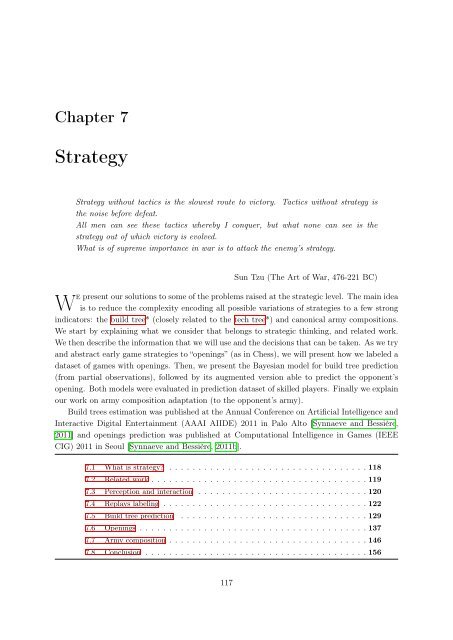Bayesian Programming and Learning for Multi-Player Video Games ...
Bayesian Programming and Learning for Multi-Player Video Games ...
Bayesian Programming and Learning for Multi-Player Video Games ...
You also want an ePaper? Increase the reach of your titles
YUMPU automatically turns print PDFs into web optimized ePapers that Google loves.
Chapter 7<br />
Strategy<br />
Strategy without tactics is the slowest route to victory. Tactics without strategy is<br />
the noise be<strong>for</strong>e defeat.<br />
All men can see these tactics whereby I conquer, but what none can see is the<br />
strategy out of which victory is evolved.<br />
What is of supreme importance in war is to attack the enemy’s strategy.<br />
Sun Tzu (The Art of War, 476-221 BC)<br />
We present our solutions to some of the problems raised at the strategic level. The main idea<br />
is to reduce the complexity encoding all possible variations of strategies to a few strong<br />
indicators: the build tree* (closely related to the tech tree*) <strong>and</strong> canonical army compositions.<br />
We start by explaining what we consider that belongs to strategic thinking, <strong>and</strong> related work.<br />
We then describe the in<strong>for</strong>mation that we will use <strong>and</strong> the decisions that can be taken. As we try<br />
<strong>and</strong> abstract early game strategies to “openings” (as in Chess), we will present how we labeled a<br />
dataset of games with openings. Then, we present the <strong>Bayesian</strong> model <strong>for</strong> build tree prediction<br />
(from partial observations), followed by its augmented version able to predict the opponent’s<br />
opening. Both models were evaluated in prediction dataset of skilled players. Finally we explain<br />
our work on army composition adaptation (to the opponent’s army).<br />
Build trees estimation was published at the Annual Conference on Artificial Intelligence <strong>and</strong><br />
Interactive Digital Entertainment (AAAI AIIDE) 2011 in Palo Alto [Synnaeve <strong>and</strong> Bessière,<br />
2011] <strong>and</strong> openings prediction was published at Computational Intelligence in <strong>Games</strong> (IEEE<br />
CIG) 2011 in Seoul [Synnaeve <strong>and</strong> Bessière, 2011b].<br />
7.1 What is strategy? . . . . . . . . . . . . . . . . . . . . . . . . . . . . . . . . . . 118<br />
7.2 Related work . . . . . . . . . . . . . . . . . . . . . . . . . . . . . . . . . . . . . 119<br />
7.3 Perception <strong>and</strong> interaction . . . . . . . . . . . . . . . . . . . . . . . . . . . . . 120<br />
7.4 Replays labeling . . . . . . . . . . . . . . . . . . . . . . . . . . . . . . . . . . . 122<br />
7.5 Build tree prediction . . . . . . . . . . . . . . . . . . . . . . . . . . . . . . . . 129<br />
7.6 Openings . . . . . . . . . . . . . . . . . . . . . . . . . . . . . . . . . . . . . . . 137<br />
7.7 Army composition . . . . . . . . . . . . . . . . . . . . . . . . . . . . . . . . . . 146<br />
7.8 Conclusion . . . . . . . . . . . . . . . . . . . . . . . . . . . . . . . . . . . . . . 156<br />
117


